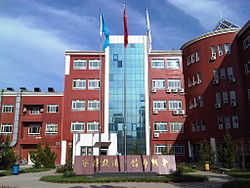Daxing District
Daxing
大兴区 | |
|---|---|
District | |
 Beijing Institute of Petrochemical Technology | |
 | |
 Daxing District in Beijing | |
| Coordinates: 39°43′37″N 116°20′29″E / 39.7269°N 116.3414°ECoordinates: 39°43′37″N 116°20′29″E / 39.7269°N 116.3414°E | |
| Country | People's Republic of China |
| Municipality | Beijing |
| Township-level divisions | 10 subdistricts 9 towns |
| District seat | (兴丰街道) |
| Area | |
| • Total | 1,012 km2 (391 sq mi) |
| Population (2000) | |
| • Total | 671,444 |
| • Density | 660/km2 (1,700/sq mi) |
| Time zone | UTC+8 (China Standard) |
| Area code(s) | 0010 |
Daxing District (simplified Chinese: 大兴区; traditional Chinese: 大興區; pinyin: Dàxīng Qū) is a district of Beijing, covering the southern suburbs of the city. It borders the Beijing districts of Tongzhou to the east/northeast, Fangshan to the west, Fengtai to the northwest, and Chaoyang to the northeast, as well as Hebei province to the south.
Overview[]
Daxing District was upgraded from a county to a district with the approval from the State Council on April 30, 2001.[citation needed] Covering an area of 1,012 square kilometres (391 sq mi) with a population of 671,444,[1] Panggezhuang in Daxing is famous for its watermelons.[citation needed]
Administrative divisions[]
There are 5 subdistricts, 14 towns with 5 towns of which carry the "area" (地区) label in the district, and one development area:[2][3]
| Name | Chinese (S) | Hanyu Pinyin | Population (2010)[4] | Area (km2) |
|---|---|---|---|---|
| 兴丰街道 | Xìngfēng Jiēdào | 57,478 | 9.66 | |
| 林校路街道 | Línxiàolù Jiēdào | 50,917 | 12.65 | |
| 清源街道 | Qīngyuán Jiēdào | 102,402 | 5.58 | |
| 观音寺街道 | Guānyīnsì Jiēdào | 73,061 | 16.40 | |
| 天宫院街道 | Tiāngōngyuàn Jiēdào | 22,433 | 33.30 | |
| Yizhuang (town) Area | 亦庄(镇)地区 | Yìzhuāng (Zhèn) Dìqū | 55,318 | 39.63 |
| ↳ Beijing Economic and Technological Development Area | 北京经济技术开发区 | Běijīng Jīngjì Jìshù Kāifāqū | 73,112 | 46.80 |
| (town) Area | 黄村(镇)地区 | Huángcūn (Zhèn) Dìqū | 168,444 | 35.00 |
| Jiugong (town) Area | 旧宫(镇)地区 | Jiùgōng (Zhèn) Dìqū | 193,585 | 29.73 |
| (town) Area | 西红门(镇)地区 | Xīhóngmén (Zhèn) Dìqū | 141,355 | 31.20 |
| Yinghai (town) Area | 瀛海(镇)地区 | Yínghǎi (Zhèn) Dìqū | 49,612 | 36.79 |
| town | 青云店镇 | Qīngyúndiàn Zhèn | 69,157 | 70.00 |
| town | 采育镇 | Cǎiyù Zhèn | 34,073 | 71.6 |
| town | 安定镇 | Āndìng Zhèn | 29,963 | 78.00 |
| town | 礼贤镇 | Lǐxián Zhèn | 33,347 | 92.06 |
| town | 榆垡镇 | Yúfá Zhèn | 56,002 | 136.00 |
| town | 庞各庄镇 | Pánggèzhuāng Zhèn | 46,632 | 109.30 |
| town | 北臧村镇 | Běizāngcūn Zhèn | 31,524 | 60.00 |
| town | 魏善庄镇 | Wèishànzhuāng Zhèn | 43,712 | 81.5 |
| town | 长子营镇 | Zhǎngzǐyíng Zhèn | 32,985 | 63.00 |
Culture[]
Located in the south of Beijing, the area is not as affluent as those that most visitors to Beijing are familiar with, such as Xidan and Guomao. Much of the industry in Daxing is related to distribution of food and consumer goods to service Beijing. There are many self-built communities casually created by the residents themselves, mostly of whom have moved in from the countryside.[citation needed]
Government and infrastructure[]
The Beijing Municipal Administration of Prisons operates the following correctional facilities in the district:
Economy[]
Xiabu Xiabu has its headquarters in Daxing District.[7]
Education[]
There are two major universities located in Daxing District, the Beijing Institute of Petrochemical Technology and the Beijing Institute of Graphic Communication. Both of them are headquartered in Qingyuan (清源), and have its branch in Kangzhuang (康庄). Qingyuan and Kangzhuang are planned as a university town in Daxing District. The Yang Guang Qing School of Beijing is also located in the district.
National Seminary of Catholic Church in China is in Daxing District.[8]
Transportation[]
The Chinese government voted in 2009 that Daxing would be the location of the Beijing Daxing International Airport.[9] The airport was opened in September 2019.
Metro[]
Daxing is currently served by four metro lines of the Beijing Subway:
 Line 8 - Demao, Yinghai
Line 8 - Demao, Yinghai Daxing line - Xihongmen, Gaomidian North, Gaomidian South, Zaoyuan, Qingyuanlu, Huangcun Xidajie, Huangcun Railway Station, Yihezhuang, Biomedical Base, Tiangongyuan
Daxing line - Xihongmen, Gaomidian North, Gaomidian South, Zaoyuan, Qingyuanlu, Huangcun Xidajie, Huangcun Railway Station, Yihezhuang, Biomedical Base, Tiangongyuan Yizhuang line - Jiugong, Yizhuangqiao, Yizhuang Culture Park, Wanyuanjie, Rongjingdongjie, Rongchangdongjie
Yizhuang line - Jiugong, Yizhuangqiao, Yizhuang Culture Park, Wanyuanjie, Rongjingdongjie, Rongchangdongjie Daxing Airport Express - Daxing Xincheng
Daxing Airport Express - Daxing Xincheng
References[]
| Wikivoyage has a travel guide for Daxing District. |
- ^ 2000 Census.
- ^ These towns are officially classified as subdistricts, but as they coincide with the area of the same name, they are commonly named "areas" (地区)
- ^ 2011年统计用区划代码和城乡划分代码:大兴区 (in Chinese). National Bureau of Statistics of the People's Republic of China. Retrieved 2013-02-23.[permanent dead link]
- ^ Census Office of the State Council of the People's Republic of China; Population and Employment Statistics Division of the National Bureau of Statistics of the People's Republic of China (2012). 中国2010人口普查分乡、镇、街道资料 (1 ed.). Beijing: China Statistics Print. ISBN 978-7-5037-6660-2.
- ^ "监狱简介 Archived 2015-05-18 at the Wayback Machine." Beijing Municipal Prison. Retrieved on 15 May 2015. "通信地址:北京市大兴区219信箱"
- ^ Home page Archived 2015-07-05 at the Wayback Machine. Beijing Women's Prison. Retrieved on May 15, 2015. "地址:北京市大兴区"
- ^ "呷哺呷哺餐饮管理有限公司招聘启事" (Archive). Beijing University of Agriculture. 2014-04-23. "我们的联系方式 呷哺呷哺(中国)总部地址:北京市大兴区黄村镇孙村工业开发区海鑫南路15号"
- ^ "Home". National Seminary of Catholic Church in China. Retrieved 2020-08-17.
版权所有:中国天主教神哲学院 地址:北京市大兴区兴业大街圣和巷5号 邮编:102600
- ^ "Daxing to get Beijing's 2nd airport - People's Daily Online".
- Daxing District
- Districts of Beijing


